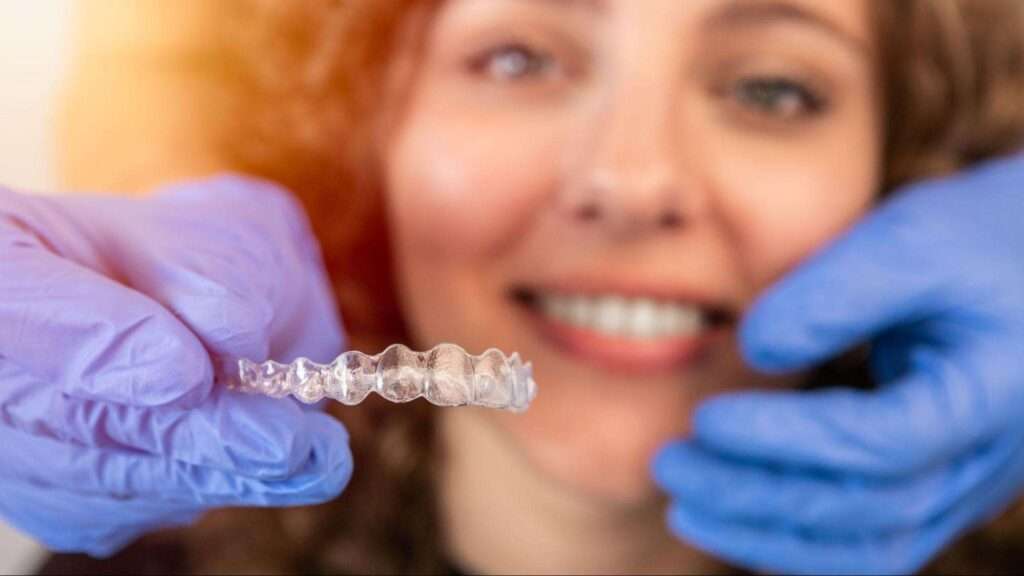
Straight teeth can profoundly transform self-confidence, oral health, and overall appearance. The dream of a perfect smile is not just a fantasy but a tangible goal. The journey to straight teeth may raise questions about how long the process will take. However, with the myriad options available today, the treatment duration can vary significantly based on individual needs and the chosen treatment. Understanding these factors helps manage expectations and leads to better decisions.
Factors That Affect How Long It Takes to Get Straight Teeth
Every patient’s case is unique, meaning the timeline can vary from one person to the next. Factors that affect the timeline include the severity of the misalignment, age, and the type of orthodontic treatment used.
Misalignment Severity
Severe dental issues, such as overbites, underbites, or crossbites, will take longer to correct. Minor cases, such as slight crowding or spacing, can often be resolved in a much shorter period. Complex cases may require more intensive intervention and adjustments over time. Your dentist or orthodontist will assess your needs before providing an estimated timeline.
Patient’s Age
Younger patients typically experience quicker results because their teeth and jaw are growing and more adaptable to orthodontic adjustments. Adult patients may need more time since their bones have stopped developing, making moving teeth into new positions harder. However, treatment is still highly effective for adults despite taking longer. Age also affects bone density and the responsiveness of teeth to movement.
Treatment Method
The type of orthodontic treatment chosen significantly impacts the length of the straightening process. Traditional braces generally take longer to achieve results than newer methods like clear aligners or accelerated braces. Choosing a faster treatment option, such as clear aligners or self-ligating braces, may shorten the timeline while delivering effective results.
Patient Compliance
How well you follow your orthodontist’s advice directly affects the speed of treatment. Wearing aligners as directed, maintaining proper oral hygiene, and attending regular appointments can ensure that treatment progresses smoothly and efficiently. Delays in treatment can occur if these guidelines are not followed, leading to extended timelines or complications.
Types of Treatment for Straightening Teeth and Timeframes
Different orthodontic treatment methods offer varying timelines for achieving straight teeth. The treatment choice will depend on factors like the severity of misalignment, lifestyle preferences, and how quickly you want results.
Traditional Metal Braces
Metal braces are the most common and well-known orthodontic treatment. They are highly effective but typically require an extended treatment period, ranging from 18 months to three years. Metal brackets and wires gradually shift the teeth into alignment over time. While they are visible, they remain a reliable choice for complex cases.
Clear Aligners
Clear aligners have become increasingly popular for their nearly invisible appearance. Treatment with aligners can last between six months to 18 months, depending on the case’s complexity. These custom-made trays are replaced every few weeks, gradually moving teeth without metal brackets.
Ceramic Braces
Ceramic braces function similarly to traditional metal braces but use tooth-colored or clear brackets. These braces offer a more discreet option while still providing the same level of effectiveness. The treatment timeline typically ranges from 18 months to three years, much like metal braces. However, if proper care isn’t taken, ceramic braces may stain over time.
Lingual Braces
Lingual braces are attached to the inside surfaces of your teeth, making them invisible from the outside. Like traditional braces, straightening teeth can take 18 months to three years. Lingual braces are particularly suited for individuals who want a wholly hidden treatment option. However, due to their positioning, they can be more uncomfortable initially.

How Age Impacts the Duration of Teeth Straightening
Orthodontic treatments work faster and more effectively in younger patients due to their still-developing jaw structure. However, adults can also see great results, although they may require more time for the process to be effective.
Children and Teens
Because children’s jaws are still growing, orthodontic treatments can help guide their teeth and bone structure into the correct alignment. It allows for quicker and more comprehensive results, often reducing treatment time to between 12 and 24 months. Growth can be directed with appliances, making early intervention more effective. Treating misalignments early on prevents more serious issues from developing later in life.
Adults
The process may take longer for adults because the jawbone has fully developed, making teeth more movement-resistant. Treatment may range from 18 months to three years, depending on the severity of misalignment. Adults may also face additional complications, such as gum disease or missing teeth, which could extend the treatment time. Despite these challenges, orthodontic treatments can still deliver excellent results for adults.
Late Treatments
Although straightening teeth later in life is still possible, it typically takes longer than during adolescence. Late treatments may also require more comprehensive orthodontic solutions, including potential surgeries in severe cases. Additionally, results may be less dramatic for older patients than younger individuals. Nonetheless, improving alignment at any age can still bring significant health benefits.
Growth Opportunities
Younger patients have the advantage of ongoing growth, which makes teeth more responsive to treatment. Certain orthodontic appliances can harness natural growth patterns to accelerate the teeth-straightening process. In adults, however, the lack of growth means treatment focuses entirely on repositioning teeth within the existing bone structure. This difference makes treatment faster for younger patients and slower for adults.
Why Compliance Is Key in Shortening Straight Teeth Treatment
While the type of treatment and age are critical factors, patient compliance is equally vital regarding how long it takes to straighten teeth. Consistently following your orthodontist’s instructions can significantly reduce treatment time and improve results. The more diligent you are with care and maintenance, the smoother and faster the process will be.
Wearing Appliances as Directed
Aligners must be worn for at least 22 hours daily to be effective. Removing them too often or for too long can significantly prolong the treatment timeline. Skipping even a day of wearing your aligners can delay straightening, leading to extended treatment time. Wearing elastics or other prescribed devices as instructed for braces is essential for keeping treatment on track.
Regular Dental Visits
Attending all scheduled appointments with your orthodontist is essential. These visits allow necessary adjustments to keep the treatment progressing smoothly. Skipping appointments can result in delays, as adjustments need to be made consistently. Missing multiple visits can lead to treatment taking longer than initially anticipated.
Good Oral Hygiene
Proper oral hygiene is vital during orthodontic treatment. If not cleaned thoroughly, braces and aligners can trap food and plaque, leading to cavities and gum disease. Dental issues can cause treatment delays, which must be addressed before continuing. Taking care of your teeth during treatment ens
Dietary Restrictions
Following dietary guidelines is crucial for patients with braces to prevent damage to the brackets and wires. Hard or sticky foods can break or loosen your braces, causing setbacks. It could result in additional visits and repairs, extending the treatment duration. Avoiding foods that can cause damage helps you stay on track with your treatment plan.

Speeding Up the Teeth Straightening Process
If you’re eager to get straight teeth faster, there are ways to help accelerate the process. These methods range from adopting simple habits to using advanced orthodontic technology. While no treatment can provide instant results, these options can help shave some time off your journey to a straighter smile.
AcceleDent or VPro
These devices use gentle vibrations to stimulate bone remodeling around the teeth. It allows for faster movement, potentially shortening treatment time by several months. AcceleDent is typically used for about 20 minutes daily and can be combined with braces or aligners. However, the effectiveness of these devices can vary depending on the individual.
Regular Adjustments
Keeping regular orthodontist appointments ensures that your treatment stays on track. Frequent adjustments help maintain momentum in the straightening process, avoiding unnecessary delays. Missing or postponing adjustments can result in slower progress, so sticking to your appointment schedule is crucial. Adjustments also allow your orthodontist to identify any issues early on and correct them quickly.
Short-Term Braces
Short-term braces may be an option for patients who need only minor corrections. These braces can often deliver results in as little as six to nine months. While not suitable for complex cases, short-term braces provide a quicker solution for individuals with mild misalignment. This option is particularly appealing to adults looking for fast, effective results.
Advanced Technology
Many modern orthodontic treatments use computer-assisted planning to create customized aligners or braces. This precision can help speed up the process by more effectively targeting specific areas of misalignment. These advanced treatments allow for more efficient tooth movement, reducing treatment time. Aligners like Invisalign, planned with 3D imaging technology, are a prime ex
Challenges That May Delay Teeth Straightening
Even with the best-laid plans, some challenges can delay your progress toward straighter teeth. Knowing these potential roadblocks can help you avoid setbacks and stay on track with your treatment.
Oral Health Issues
Pre-existing conditions like gum disease or cavities can delay the start of treatment. In some cases, these issues must be addressed before braces or aligners can be applied. If dental problems arise during treatment, they may also halt progress until they are resolved. Regular cleanings and check-ups with your dentist can help prevent these complications.
Broken Appliances
If a bracket or wire breaks, it can set back your treatment timeline. Repairs must be made before the straightening process can continue, which may result in additional visits. That is especially true for patients with braces, as damaged brackets or wires can compromise the treatment’s effectiveness. Taking care of your braces and avoiding hard or sticky foods helps minimize this risk.
Improper Fit
Sometimes, aligners or braces may not fit properly due to changes in the teeth or a mistake during manufacturing. Ill-fitting appliances can hinder progress, requiring adjustments or new aligners, resulting in delays, as correcting the fit can take time. Working closely with your orthodontist ensures that any issues with the fit are addressed promptly.
Non-Compliance
Failing to follow instructions, whether wearing aligners as prescribed or not, maintaining good oral hygiene can significantly extend treatment time. Non-compliance slows the teeth-straightening process and may result in setbacks that take additional time to fix. It can be incredibly frustrating for patients eager to see results. Sticking to the treatment plan and attending regular appointments are crucial to avoiding delays.
Your Path to Straight Teeth
Straightening your teeth is more than just a cosmetic improvement—it’s a journey toward better oral health and self-confidence. With first-class aligner treatments, you can experience a customized and discrete approach that fits seamlessly into your daily routine. These advanced treatments provide comfort and efficiency, making your path to a beautiful, healthy smile smoother and faster. A first-class smile is not just about aesthetics; it’s about embracing long-lasting benefits that improve your overall well-being.
Discover the latest orthodontic care and aligner treatments on our FirstClass Aligners blog.






